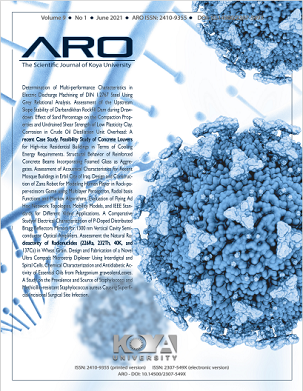A Comparative Study of Electrical Characterization of P-Doped Distributed Bragg Reflectors Mirrors for 1300 nm Vertical Cavity Semiconductor Optical Amplifiers
DOI:
https://doi.org/10.14500/aro.10741Keywords:
AlGaAs/GaAs, Current-voltage, Distributed Bragg reflectors, MobilityAbstract
This paper presents an electrical analysis of various diameters of two p-types of GaAs/Al0.9Ga0.1As and two p-types of GaAs/Al0.3Ga0.7As/Al0.9Ga0.1As distributed Bragg reflectors (DBRs) mirrors structure grown on undoped and on p-doped GaAs, which affects the characteristics of 1300 nm vertical cavity surface emitting lasers (VCSELs) and vertical cavity semiconductor optical amplifiers (VCSOAs). Electrical characterizations and Hall measurements of current−voltage (IV) for GaAs/Al0.9Ga0.1As linear DBRs and GaAs/Al0.3Ga0.7As/Al0.9Ga0.1 As graded DBRs were also performed at temperatures between 13 and 300 K. Consequently, p-type DBRs are designed with graded composition interfaces technique. The smaller mesa diameters are used to reduce vertical and longitudinal resistances and to limit the heating effect and improve the characteristics of VCSEL/VCSOA devices.
Downloads
References
Chaqmaqchee, F., Abubekr Salh, S. and Sabri, M.M., 2020. Optical analysis of 1300 nm GaInNAsSb/GaAs vertical cavity semiconductor optical amplifier, Zanco Journal of Pure and Applied Sciences, 32(2), pp.87-92.
Chaqmaqchee, F.A.I. and Lott, J.A., 2020. Impact of oxide aperture diameter on optical output power, spectral emission, and bandwidth for 980 nm VCSELs. OSA Continuum, 3(9), pp.2602-2613.
Chaqmaqchee, F.A.I., 2019. Performance characteristics of conventional vertical cavity surface emitting lasers VCSELs at 1300 nm. ZANCO Journal of Pure and Applied Sciences, 31(2), pp.14-18.
Chaqmaqchee, F.A.I., Mazzucato, S., Sun, Y., Balkan, N., Tiras, E., Hugues, M. and Hopkinson, M., 2012. Electrical characterisation of p-doped distributed Bragg reflectors in electrically pumped GaInNAs VCSOAs for 1.3 mu operation. Materials Science and Engineering B, 177(10), pp.739-743.
Croquette, K.D. and Hou, H.Q., 1997. Vertical-cavity surface emitting lasers: Moving from research to manufacturing, Proceedings of the IEEE, 85(11), pp.1730-1739.
Garmire, E., 2003. Theory of quarter-wave-stack dielectric mirrors used in a thin Fabry-Perot filter. Applied Optics, 42, pp.5442-5449.
Macleod, H.A., 2018. Thin-film Optical Filters, CRC Press, Taylor and Francis, Arizona, USA.
Marciniak, M., Gebski, M., Broda, A., Muszalski, J., Czyszanowski, T. and Lott, J.A., 2020. Impact of Top Mirror Power Reflectance on 980-nm VCSEL Performance. Vol. 11300. Proceedings SPIE. Nabiev, R.F. and Chang-Hasnain, C.J., 1995. Voltage drop in n- and p-type Bragg reflectors for vertical-cavity surface-emitting lasers. IEEE Photonics Technology Letters, 7(7), pp.733-735.
Ogura, M., Hata, T., Kawai, N.J. and Yao, T., 1983. GaAs/AlxGa1–xAs multilayer reflector for surface emitting laser diode. Japanese Journal of Applied Physics, 22(2A), pp.L112-L114.
Pickrella, G.W., Louderbacka, D.A., Fisha, M.A., Hindia, J.J., Lina, H.C., Simpsona, M.C., Guilfoylea, P.S. and Lear, K.L., 2005. Compositional grading in distributed Bragg reflectors, using discrete alloys, in vertical-cavity surfaceemitting lasers. Journal of Crystal Growth, 280(1-2), pp.54-59.
Pohl, J., Cole, G.D., Zeimer, U., Aspelmeyer, M. and Weyers, M., 2018. Reduction of absorption losses in MOVPE-grown AlGaAs Bragg mirrors. Optics Letters, 43(15), pp.3522-3525.
Wang, G., Li, K., Chen, S. and Yang, H., 2019. Analysis of pulse amplification characteristics in vertical cavity semiconductor optical amplifiers. Journal Integrated Ferroelectrics, 198(1), pp.39-54.
Winston, D.W. and Hayes, R.E., 1998. Optoelectronic device simulation of Bragg reflectors and their influence on surface-emitting laser characteristics, IEEE Journal of Electronics, 34(4), pp.711.
Zhang, C., ElAfandy, R. and Han, J., 2019. Distributed Bragg reflectors for GaN-based vertical-cavity surface-emitting lasers, Applied Sciences, 9(8), pp.1-20.
Downloads
Published
How to Cite
Issue
Section
License
Authors who choose to publish their work with Aro agree to the following terms:
-
Authors retain the copyright to their work and grant the journal the right of first publication. The work is simultaneously licensed under a Creative Commons Attribution License [CC BY-NC-SA 4.0]. This license allows others to share the work with an acknowledgement of the work's authorship and initial publication in this journal.
-
Authors have the freedom to enter into separate agreements for the non-exclusive distribution of the journal's published version of the work. This includes options such as posting it to an institutional repository or publishing it in a book, as long as proper acknowledgement is given to its initial publication in this journal.
-
Authors are encouraged to share and post their work online, including in institutional repositories or on their personal websites, both prior to and during the submission process. This practice can lead to productive exchanges and increase the visibility and citation of the published work.
By agreeing to these terms, authors acknowledge the importance of open access and the benefits it brings to the scholarly community.
Accepted 2021-04-29
Published 2021-06-03
















 ARO Journal is a scientific, peer-reviewed, periodical, and diamond OAJ that has no APC or ASC.
ARO Journal is a scientific, peer-reviewed, periodical, and diamond OAJ that has no APC or ASC.